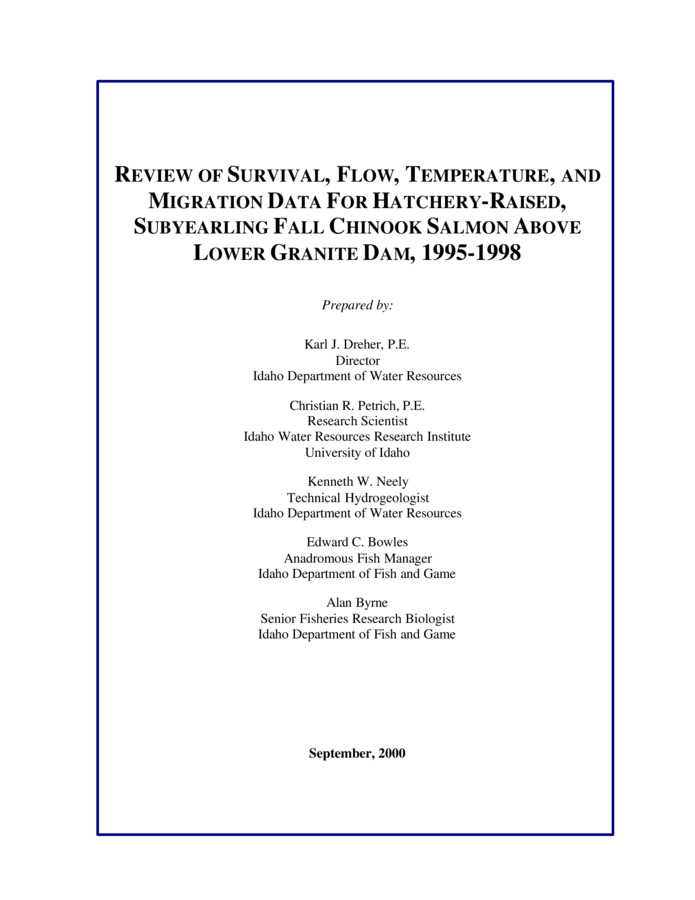PDF
Review of survival, flow, temperature, and migration data for hatchery-raised subyearling fall chinook salmon above Lower Granite Dam, 1995-1998 Item Info
- Title:
- Review of survival, flow, temperature, and migration data for hatchery-raised subyearling fall chinook salmon above Lower Granite Dam, 1995-1998
- Authors:
- Dreher, Karl J.; Petrich, Christian, R.; Neely, Kenneth W.; Bowles, Edward C.; Byrne, Alan
- Date:
- 2000-09
- Description:
- The effectiveness of flow augmentation in aiding conservation and recovery of Snake River salmonid populations listed under the Endangered Species Act is questionable. The purpose of flow augmentation has been largely to increase the velocity and/or reduce the temperature of water flowing through mainstem reservoirs in the lower Snake and Columbia Rivers. Although improved adult returns are generally associated with good water years (e.g., high natural flow and spill) during juvenile outmigration, the efficacy of flow augmentation as a substitute for good water years has not been defensibly established. During the period from 1995 through 1998, the National Marine Fisheries Service (NMFS), the U.S. Fish and Wildlife Service, and the Nez Perce Tribe investigated migration characteristics of hatchery-raised, subyearling fall chinook salmon (Oncorhynchus tshawytscha) in the Snake River Basin (Muir et al., 1999). Hatchery raised sub yearlings were used as surrogates for wild sub yearlings in the survival research. The studies showed that estimated survival from points of release to the tailrace of Lower Granite Dam could be correlated with all three environmental variables examined (flow rate, water temperature, and turbidity). Estimated survival decreased throughout the season, as flow volume and turbidity decreased and water temperature increased (Muir et al., 1999). These correlations have provided the primary basis for the continuation of flow augmentation from reservoirs in the Snake River and Clearwater River Basins (NMFS, 1999). The purpose of this report is to provide a review of the data considered in the Muir et al. (1999) study within the context of determining the efficacy of flow augmentation for enhancing the survival of subyearling fall chinook. In particular, relationships between flow rates, water temperatures, travel times, and estimated survival of hatchery-raised, subyearling fall chinook salmon between points of release and detections at Lower Granite Dam are examined. This report includes analyses of: (1) flow rates and water temperatures at Lower Granite Dam; (2) estimated survival with 5th percentile flow indices; (3) estimated survival and 5th percentile water temperature indices; (4) estimated survival versus release dates; (5) estimated survival versus release groups; and (6) fall chinook travel times and numbers of detections. Finally, these comparisons are used to draw conclusions about flow rates, travel times, subyearling survival, and effectiveness of flow augmentation.
- Subjects:
- flow augmentation salmon salmonid fish migration survival
- Location:
- Lower Snake River; Northern Idaho
- Idaho County:
- Nez Perce County
- Latitude:
- 46.66
- Longitude:
- -117.43
- Source:
- Idaho Water Resources Research Institute, University of Idaho
- Identifier:
- IWRRI Number 200003
- Publisher:
- Idaho Water Resources Research Institute, University of Idaho
- Contributing Institution:
- University of Idaho
- Type:
- Text
- Format:
- application/pdf
- Cataloger:
- KIT
- Language:
- eng
Source
- Preferred Citation:
- "Review of survival, flow, temperature, and migration data for hatchery-raised subyearling fall chinook salmon above Lower Granite Dam, 1995-1998", Idaho Waters Digital Library, University of Idaho Library Digital Collections, https://www.lib.uidaho.edu/digital/iwdl/items/iwdl-200003.html
Rights
- Rights:
- In copyright, educational use permitted. Educational use includes non-commercial reproduction of text and images in materials for teaching and research purposes. For other contexts beyond fair use, including digital reproduction, please contact the University of Idaho Library Special Collections and Archives Department at libspec@uidaho.edu. The University of Idaho Library is not liable for any violations of the law by users.
- Standardized Rights:
- http://rightsstatements.org/vocab/InC-EDU/1.0/

